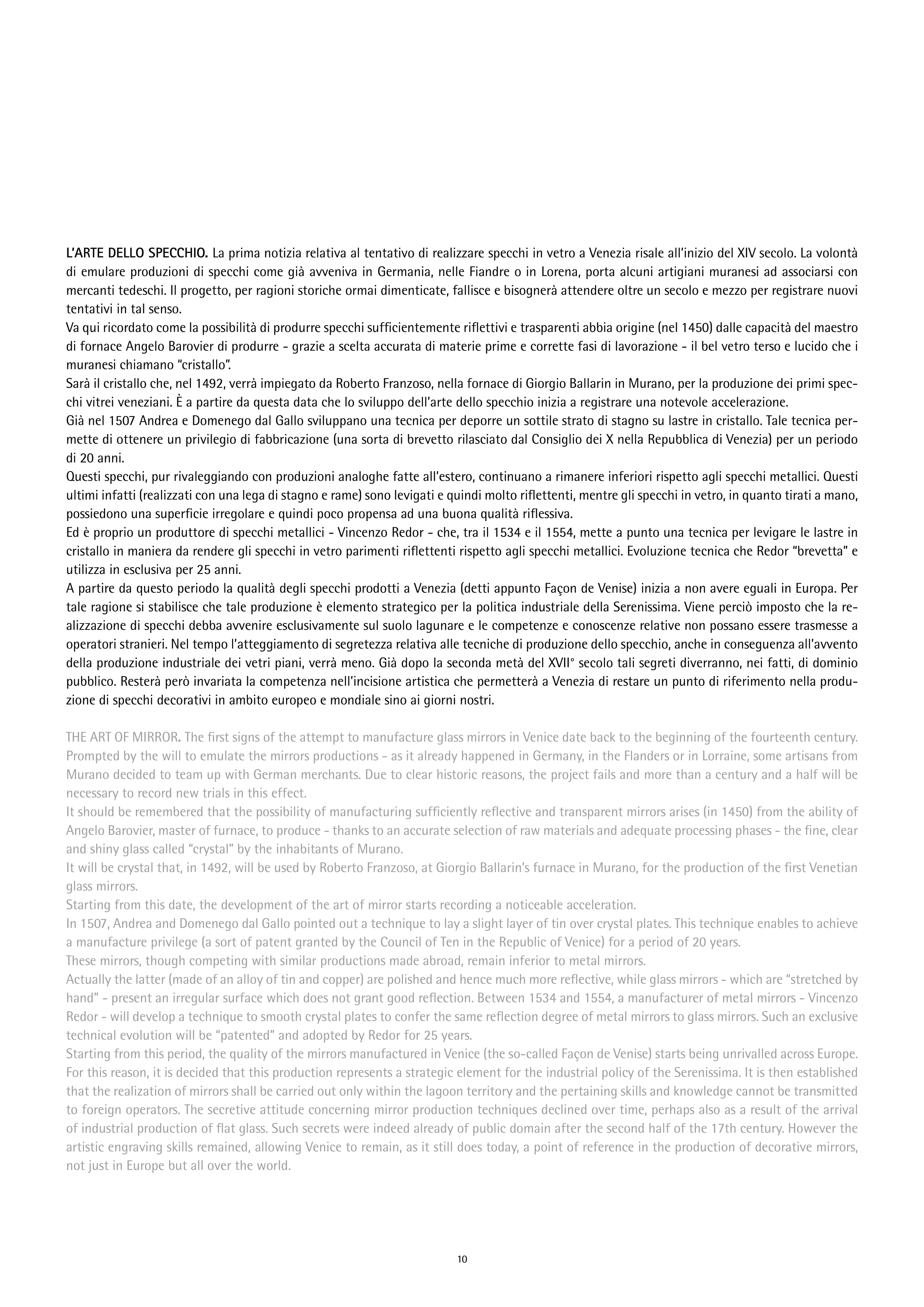L’ARTE DELLO SPECCHIO. La prima notizia relativa al tentativo di realizzare specchi in vetro a Venezia risale all’inizio del XIV secolo. La volontà
di emulare produzioni di specchi come già avveniva in Germania, nelle Fiandre o in Lorena, porta alcuni artigiani muranesi ad associarsi con
mercanti tedeschi. Il progetto, per ragioni storiche ormai dimenticate, fallisce e bisognerà attendere oltre un secolo e mezzo per registrare nuovi
tentativi in tal senso.
Va qui ricordato come la possibilità di produrre specchi sufficientemente riflettivi e trasparenti abbia origine (nel 1450) dalle capacità del maestro
di fornace Angelo Barovier di produrre - grazie a scelta accurata di materie prime e corrette fasi di lavorazione - il bel vetro terso e lucido che i
muranesi chiamano “cristallo”.
Sarà il cristallo che, nel 1492, verrà impiegato da Roberto Franzoso, nella fornace di Giorgio Ballarin in Murano, per la produzione dei primi spec-
chi vitrei veneziani. È a partire da questa data che lo sviluppo dell’arte dello specchio inizia a registrare una notevole accelerazione.
Già nel 1507 Andrea e Domenego dal Gallo sviluppano una tecnica per deporre un sottile strato di stagno su lastre in cristallo. Tale tecnica per-
mette di ottenere un privilegio di fabbricazione (una sorta di brevetto rilasciato dal Consiglio dei X nella Repubblica di Venezia) per un periodo
di 20 anni.
Questi specchi, pur rivaleggiando con produzioni analoghe fatte all’estero, continuano a rimanere inferiori rispetto agli specchi metallici. Questi
ultimi infatti (realizzati con una lega di stagno e rame) sono levigati e quindi molto riflettenti, mentre gli specchi in vetro, in quanto tirati a mano,
possiedono una superficie irregolare e quindi poco propensa ad una buona qualità riflessiva.
Ed è proprio un produttore di specchi metallici - Vincenzo Redor - che, tra il 1534 e il 1554, mette a punto una tecnica per levigare le lastre in
cristallo in maniera da rendere gli specchi in vetro parimenti riflettenti rispetto agli specchi metallici. Evoluzione tecnica che Redor “brevetta” e
utilizza in esclusiva per 25 anni.
A partire da questo periodo la qualità degli specchi prodotti a Venezia (detti appunto Façon de Venise) inizia a non avere eguali in Europa. Per
tale ragione si stabilisce che tale produzione è elemento strategico per la politica industriale della Serenissima. Viene perciò imposto che la re-
alizzazione di specchi debba avvenire esclusivamente sul suolo lagunare e le competenze e conoscenze relative non possano essere trasmesse a
operatori stranieri. Nel tempo l’atteggiamento di segretezza relativa alle tecniche di produzione dello specchio, anche in conseguenza all’avvento
della produzione industriale dei vetri piani, verrà meno. Già dopo la seconda metà del XVII° secolo tali segreti diverranno, nei fatti, di dominio
pubblico. Resterà però invariata la competenza nell’incisione artistica che permetterà a Venezia di restare un punto di riferimento nella produ-
zione di specchi decorativi in ambito europeo e mondiale sino ai giorni nostri.
THE ART OF MIRROR. The first signs of the attempt to manufacture glass mirrors in Venice date back to the beginning of the fourteenth century.
Prompted by the will to emulate the mirrors productions - as it already happened in Germany, in the Flanders or in Lorraine, some artisans from
Murano decided to team up with German merchants. Due to clear historic reasons, the project fails and more than a century and a half will be
necessary to record new trials in this effect.
It should be remembered that the possibility of manufacturing sufficiently reflective and transparent mirrors arises (in 1450) from the ability of
Angelo Barovier, master of furnace, to produce - thanks to an accurate selection of raw materials and adequate processing phases - the fine, clear
and shiny glass called “crystal” by the inhabitants of Murano.
It will be crystal that, in 1492, will be used by Roberto Franzoso, at Giorgio Ballarin’s furnace in Murano, for the production of the first Venetian
glass mirrors.
Starting from this date, the development of the art of mirror starts recording a noticeable acceleration.
In 1507, Andrea and Domenego dal Gallo pointed out a technique to lay a slight layer of tin over crystal plates. This technique enables to achieve
a manufacture privilege (a sort of patent granted by the Council of Ten in the Republic of Venice) for a period of 20 years.
These mirrors, though competing with similar productions made abroad, remain inferior to metal mirrors.
Actually the latter (made of an alloy of tin and copper) are polished and hence much more reflective, while glass mirrors - which are “stretched by
hand” - present an irregular surface which does not grant good reflection. Between 1534 and 1554, a manufacturer of metal mirrors - Vincenzo
Redor - will develop a technique to smooth crystal plates to confer the same reflection degree of metal mirrors to glass mirrors. Such an exclusive
technical evolution will be “patented” and adopted by Redor for 25 years.
Starting from this period, the quality of the mirrors manufactured in Venice (the so-called Façon de Venise) starts being unrivalled across Europe.
For this reason, it is decided that this production represents a strategic element for the industrial policy of the Serenissima. It is then established
that the realization of mirrors shall be carried out only within the lagoon territory and the pertaining skills and knowledge cannot be transmitted
to foreign operators. The secretive attitude concerning mirror production techniques declined over time, perhaps also as a result of the arrival
of industrial production of flat glass. Such secrets were indeed already of public domain after the second half of the 17th century. However the
artistic engraving skills remained, allowing Venice to remain, as it still does today, a point of reference in the production of decorative mirrors,
not just in Europe but all over the world.
10


